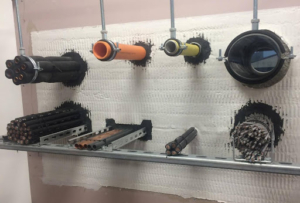Though the 60/40 rule is not an official guideline anymore, it is still valued within our industry. It was essential when dealing with multi-service penetrations, such as gas pipes, conduits with cables, and heating pipework that penetrated compartment walls or floors. This rule required that the opening should be at most 60% of services passing through, with the remaining 40% reserved for firestopping materials.

This was part of the BS EN 1366-3:2009 fire-resistance test standard for service penetrations, which stated:
The test results obtained using standard wall and floor configurations for penetration systems are valid for penetration size (in terms of linear dimensions) equal to or smaller than tested, provided the total amount of cross sections of services (including insulation) does not exceed 60% of the penetration area, the working clearances are not smaller than the minimum working clearances (as defined in Annex A, B, E, and F) used in the test and a blank penetration seal of the maximum seal size desired was tested in addition.
Significant changes were introduced to the test standard in 2021. One of the changes was the removal of the 60/40 guideline and the inclusion of section 13.4.2, which states:
The total number of services (pipes, cables, conduits, trunking, etc.) testing within a specific penetration seal may be increased without restriction, so long as the distances between the services, and between the aperture edge, are not smaller than the minimum distances in 13.7 used in the test. Subject to other rules in this standard, this rule does not apply to single service penetration seals, which form an annular space.
This change was because, for some manufacturers’ evidence, more than 40% of firestopping materials inside the seal required meeting the spacing restrictions between the sealing systems. This was to be in accordance with the specimen evidence.
Many manufacturers only fire test single specimens, often 200mm, from other specimens. This means that the spacing between services, edge of the aperture, etc., is restricted due to BS EN166-3:2021, section 13.7 rules. This section requires a minimum of 100mm space from the sealing system to either the aperture edge or another service’s sealing system.
See also: What are the spacing requirements for service penetration firestop seals?
Therefore, it is crucial that when reviewing products, you review the classification document created by an accredited body. These bodies play a vital role in the industry, as they review the fire test evidence and the BS EN 1366-3 rules to generate a defined field of application, not just based on a manufacturer’s opinion or judgement. Their independent review ensures that products meet the necessary standards and are suitable for their intended use.
At Quelfire, we provide tested firestopping solutions for various applications found onsite. Gas pipes, for example, are a common type of service penetration where multiple services are grouped, and 100mm spacing between the service penetration seal is not feasible or practical.
Consequently, because of this site requirement, we have conducted extensive testing on these, where feasible, to ensure they can be installed with QuelStop HPE Sealant around the annulus of a group of pipes. See detail: QB-FW100-D-12.
However, although Quelfire pushes the boundaries with service penetrations and has a minimum spacing of 0mm between service penetration seals, we always advise MEP designers to consider all trades in the installation process. The MEP services must be practical to install, and adequate space must be allowed for the firestopping contractor to install the penetration seal. The best way to ensure this is by engaging early with all the relevant parties at the design stage before the build commences.

